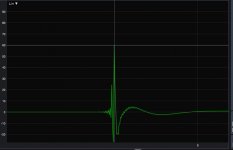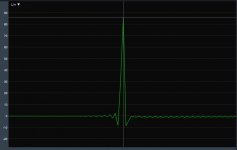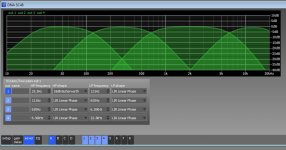Ok, I know many might object to my thread title ...don't mean to offend...
Below are two impulse responses of a 4 way system, where the response is a simple summation of the 4 electrical passbands.
So this is entirely an electical x-over summation...no speaker involved.
Both use the same x-over freqs as shown in a system overview.
The first impulse uses LR 24 dB/oct x-overs.
The second uses linear phase (FIR) crossovers, again at 24 dB/oct .
If using passive crossovers, or IIR DSP crossovers (which amounts to the same thing as passive) ....the impulse response shown is as good as it can possibly get for a speaker with theoretically perfect drivers.
As compared to to the linear-phase impulse, again with perfect drivers.
Methinks times are a changing....
Below are two impulse responses of a 4 way system, where the response is a simple summation of the 4 electrical passbands.
So this is entirely an electical x-over summation...no speaker involved.
Both use the same x-over freqs as shown in a system overview.
The first impulse uses LR 24 dB/oct x-overs.
The second uses linear phase (FIR) crossovers, again at 24 dB/oct .
If using passive crossovers, or IIR DSP crossovers (which amounts to the same thing as passive) ....the impulse response shown is as good as it can possibly get for a speaker with theoretically perfect drivers.
As compared to to the linear-phase impulse, again with perfect drivers.
Methinks times are a changing....
Attachments
I hate to break it to you, but there are already enough threads on this subject.
Au contraire
My post is not active vs passive, for which I surely agree, plenty of threads abound....
Please realize my thread is about FIR ...... yes vs passive, and also vs non-FIR active.
And sure, no such thing as perfect drivers....impulse only gets worse with imperfect drivers....
But what does that have to do with keeping x-over topology from limiting ideal response?
Frankly, and IMHO, FIR is largely ignored in multiway...which is a crying shame as ignoring it leaves so much sound quality on the table.
Last edited by a moderator:
Hate to break another thing to you, but DSP does not amount to the same thing as passive
You could have saved some grief by properly titling the subject header of this thread, and yes, I think you can still look forward to energetic discussion by folks who’ve been experimenting with all types of frequency dividing / contouring / EQ networks since well before your membership in this forum began.
We do of course look forward to relevations from all sources, so please continue
You could have saved some grief by properly titling the subject header of this thread, and yes, I think you can still look forward to energetic discussion by folks who’ve been experimenting with all types of frequency dividing / contouring / EQ networks since well before your membership in this forum began.
We do of course look forward to relevations from all sources, so please continue
Last edited:
If using passive crossovers, or IIR DSP crossovers (which amounts to the same thing as passive) ....the impulse response shown is as good as it can possibly get for a speaker with theoretically perfect drivers.
...
Methinks times are a changing....
What do I win if I post an actual measured impulse response from a 4 way completely passive speaker that looks better than that?
The first impulse uses LR 24 dB/oct x-overs.
The second uses linear phase (FIR) crossovers, again at 24 dB/oct .
And both have pre-ringing. Something that is unnatural and quite detectable by the ear/brain. Analog XOs (active or passive do not suffer from this).
I know that some DACs have modes that do not pre-ring either.
In all cases you have to pick your poison (ie compromises).
dave
And both have pre-ringing. Something that is unnatural and quite detectable by the ear/brain. Analog XOs (active or passive do not suffer from this).
...
dave
My guess is the simulation is performed predominantly in the frequency domain, and the nyquist bin isn't entirely real. When the IFFT is performed, the result is actually complex but the imaginary parts are ignored, and the real parts ring. Of course, the solution isn't to remove the imaginary part of the nyquist bin, which would create a large phase discrepancy with the proceeding bin (and wouldn't fix this issue). The solution is to apply a linear phase ramp in the frequency domain using a complex exponential in order to bring the phase of the nyquist bin to some multiple of 180 degrees. If done correctly (with the minimum amount of phase adjustment), this is equivalent to a fractional sample delay, and the ifft will result in much smaller imaginary components, and much less ringing (approximately none).
But what do I know? I still build passive crossovers and I don't even bother to apply any DSP.
Last edited:
With IIR where we can have static delay and allpass sections it is actually quite feasible to find a linear-phase (transient-perfect) LR4'ish mid-to-tweeter xover. With a bit of strategic set-back of the tweeter like in a coaxial driver it can be done in active pure analog (no delays) as well, with a few peaking allpass cells. This way, I've managed to find a very good 4th order linear-phase XO that has quasi-constant 90° phase offset between drivers in the xo region, making it an excellent choice for a d'Appolito (M-T-M) arrangement.
If this is really not a rehash of what's been covered in so many other threads, why the goofy title? Isn't this more FIR vs IIR? And isn't that discussed in other threads already?
Fair enough.
I made the mistake of thinking the title was goofy enough and with a smile, that along with an opening statement about not meaning to offend......
....that folks would grin and focus on the content...I was wrong...
My apologies....
Perhaps the only thing "new" in my post, is that the impulse responses of the 4-ways are measured, not simulated.
(I figure there have no doubt been such measurements posted, but I've always seen only sims, and usually for just a 2-way).
I was a little surprised by both how bad the 4th order LR measurement looked,
and how good the linear phase measurent looked.
I thought others might be struck by it as well.
Yes, I would love to see anyone duplicate the linear phase impulse response, with IIR and all-pass, either passively or with DSP.
I play around with doing that a lot, as i need to reduce latency for live sound applications.
It's pretty easy to get decent results I think for a 2-way where there is only one shallow-sloped x-over in play, higher up in frequency.
But at least for me, it's been impossible to use IIR and all-pass filters to actually measure well, for anything more complicated...it takes a grillion all-pass down low doesn't it?
Fair enough.
I made the mistake of thinking the title was goofy enough and with a smile, that along with an opening statement about not meaning to offend......
....that folks would grin and focus on the content...I was wrong...
My apologies....
Perhaps the only thing "new" in my post, is that the impulse responses of the 4-ways are measured, not simulated.
(I figure there have no doubt been such measurements posted, but I've always seen only sims, and usually for just a 2-way).
KO in second round! Good for you, bad for the naysayers;o)
Please, show the four way!
Tough crowd  .
.
Controversial thread titles seldom are a good idea I guess. And you're posting about a controversial subject as well.
I hope the people that posted on this thread, claiming they can do as good with IIR will share the results and details how they got there. What good is the claim to have it, if you don't share how it's done. I suppose that would have been your next move, if there were any interest?
I hope you do share what you did and how you got those results, there's always people watching (and learning). There will always be contradictory views as well.
Controversial thread titles seldom are a good idea I guess. And you're posting about a controversial subject as well.
I hope the people that posted on this thread, claiming they can do as good with IIR will share the results and details how they got there. What good is the claim to have it, if you don't share how it's done. I suppose that would have been your next move, if there were any interest?
I hope you do share what you did and how you got those results, there's always people watching (and learning). There will always be contradictory views as well.
Tough crowd.
I hope the people that posted on this thread, claiming they can do as good with IIR will share the results and details how they got there. What good is the claim to have it, if you don't share how it's done. I suppose that would have been your next move, if there were any interest?
I designed the perfect filter...but I won't reveal it here.
I'll fire up the popcorn and get some beers, just have a couple left then it's up to the liquor cabinet, set a new 22 liter round of beer 'couple days ago, only 3-4 weeks until they're good.
Active filters are always relevant and interesting, maybe you got off to a bad start, but like with everything in the audio world, and especially filters: always room for improvement.
Active filters are always relevant and interesting, maybe you got off to a bad start, but like with everything in the audio world, and especially filters: always room for improvement.
Spend 30 years or more learning about and perfecting passive filters, measuring caps, soldering, moving driver c-c distances and cabinet chamfer angles, testing silver caps against beeswax coated paper + gold with thousands of hours learning the 'dark art' for ever smaller slight gains made in your designs and finally mastery of your craft....
then some 16 yr old comes along and bests it in 10 mins on a PC that you have to ask him how to use.
How would you feel towards it?
Progress is cool, but you must forgive people for their bias. Many who post on here are in, related to or take advice from prominent members in the industry from generations gone by.....
Upton Sinclair:
"It is difficult to get a man to understand something, when his salary depends upon his not understanding it!"
Or course, passive crossovers could actually sound better. No measurement has ever indicated this though. And we can measure every parameter of vibrating air molecules we would like to as far as I know.
Of couse, the many other advantages of passive remain:
2 channels amp needed.
2 channel DAC
2 channel preamp.
A 4 way digital active speaker can get very expensive.
then some 16 yr old comes along and bests it in 10 mins on a PC that you have to ask him how to use.
How would you feel towards it?
Progress is cool, but you must forgive people for their bias. Many who post on here are in, related to or take advice from prominent members in the industry from generations gone by.....
Upton Sinclair:
"It is difficult to get a man to understand something, when his salary depends upon his not understanding it!"
Or course, passive crossovers could actually sound better. No measurement has ever indicated this though. And we can measure every parameter of vibrating air molecules we would like to as far as I know.
Of couse, the many other advantages of passive remain:
2 channels amp needed.
2 channel DAC
2 channel preamp.
A 4 way digital active speaker can get very expensive.
Last edited:
To quote Floyd Toole:
and Jonathan Novick, Audio Precision
We still have much to learn about measures and how to interpret them.
Saying that a measurement proves something is audible or not is a subjective choice that asserts the measurement can actually do that.
dave
Two ears and a brain are massively more analytical and adaptable than an omnidirectional microphone and an analyzer.
and Jonathan Novick, Audio Precision
Not all that matters can be measured, Not all that can be measured, matters.
We still have much to learn about measures and how to interpret them.
Saying that a measurement proves something is audible or not is a subjective choice that asserts the measurement can actually do that.
dave
- Status
- This old topic is closed. If you want to reopen this topic, contact a moderator using the "Report Post" button.
- Home
- Loudspeakers
- Multi-Way
- Why passive is passe ;)


